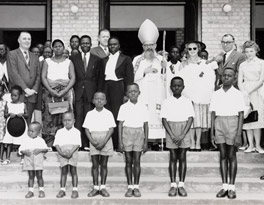A 'MODEL COLONY'
 Baptism of the 7th son in a Congolese family who is named BaudouinCirca 1960 Baptism of the 7th son in a Congolese family who is named BaudouinCirca 1960Coll. RMCA |
After the Second World War, the Ten Year Plan (Plan décennal pour le développement économique et social du Congo belge), published in June 1949, emphasizes the colony's economic and social development. The same year, the colonial administration creates Inforcongo (Centre d'Information et de Documentation du Congo Belge et du Ruanda-Urundi). Images distributed by Inforcongo, which shape perceptions of the colony to this day, analogize life in Belgian Congo to 'a long, calm river': they reflect a 'model' colony where colonized peoples are smiling, happy and safe. Yet the reality is more complex and nuanced: the effects of economic development are unequal; rural areas are neglected; obligatory cash crop cultivation, forced labour and difficult living conditions induce a rural exodus, which causes problems in cities. Workers in cities and industrial centres complain of insufficient salaries and housing ill-adapted to their needs; the 'évolués' call for equal pay for equal work; in Kasai, Bena Lulua reproach the colonial administration for favouring Baluba; in Leopoldville and in Katanga's industrial centres, those who consider themselves 'natives' feel threatened by the presence of 'immigrants'. To reinforce Belgian domination, the colonial elite reformulates its vision based on the model of a Belgo-Congolese community. But too often it reduces colonial problems to interpersonal ones between 'whites' and 'blacks', neglecting the juridical and administrative inequalities that structure their relationships. |


